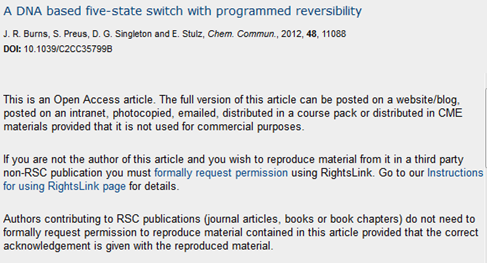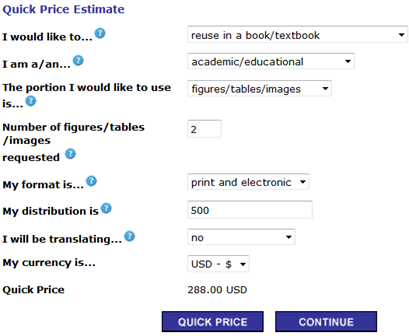In the last two posts I have shown examples of how legacy publishers charge additional money for the re-use of CC-NC (“non-commercial”) articles. I have taken examples of the Royal Society of Chemistry and Elsevier, but this is applicable to almost all “closed access” publishers. There’s been quite a lot on Twitter. I have the honour to serve as a member of the Creative Commons (CC) Science Advisory Board so even if I cannot always give a definitive answer I can get one where possible. The area is complex and fuzzy, so here’s a brief introduction:
- “Open access” (OA) is used so widely that it’s operationally meaningless. In particular a reader told that a paper is OA has no definite information about what rights, if any they have.
- CC has created a number of licences which are legal instruments valid in most countries. The following CC-licences may be relevant: CC-BY (attribution required but otherwise full reuse rights); CC-SA (sharealike, reuser have to use the same licence terms – the copyleft approach); CC-NC (Non-commercial), CC-ND (“no derivatives”); CC0 (“public domain” but this may be country-dependent). They can be mixed in many proportions (e.g. CC-BY-NC-ND – forbids any commercial use and forbids derivative works). The use of “under a CC licence” is effectively meaningless in defining “open access” – you have to specify which licence.
- The Budapest Declaration of Open Access (BOAI) defined open access operationally “By “open access” to this literature, we mean its free availability on the public internet, permitting any users to read, download, copy, distribute, print, search, or link to the full texts of these articles, crawl them for indexing, pass them as data to software, or use them for any other lawful purpose, without financial, legal, or technical barriers other than those inseparable from gaining access to the internet itself. The only constraint on reproduction and distribution, and the only role for copyright in this domain, should be to give authors control over the integrity of their work and the right to be properly acknowledged and cited.” This is clear and operationally valid.
- Unfortunately many “OA advocates” have argued and practised that simple visibility somewhere on the Internet is “open access” even though the reader/user has no rights to copy or reuse. This devalues the term so it becomes a political slogan rather than a definition. So a publisher announcing “open access” without a clear legal specification of terms is not providing value to the community. In practice many legacy publishers have a small amount of “open access” whose rights are often extremely unclear. Many publishers do not have a CC licence at all but a series of terms and conditions which are almost always unclear. Writing licences is a specialist business and most hand-crafted attempts will have seriously problems. Moreover they have to be carefully read whereas CC licences are immediately recognisable and do not have to be understood more than once.
- There are a number of people (e.g. Heather Morrison) who argue that CC-NC prevents scholars being exploited. IMO this is completely mistaken and I urge her and others to change their views as the only thing it does is increase the power and revenue of publishers.
A number of publishers have adopted CC-BY as their only Open Access licences. This is to be welcomed. All the mainstream new generation OA publishers (BMC, PLoS, eLife, PeerJ, Ubiquity, etc.) use CC-BY. I argue strongly that any publisher charging authors (APC) should offer only CC-BY. It’s a fair bargain. Authors pay publisher and publisher has no special rights thereafter. As far as I know BMC or PLoS or … has never had any problems of downstream misuse. The paradigms of scholarship and other legal concepts are sufficiently powerful: “passing off”, “fraud”, “plagiarism” are not made worse by CC-BY – in fact the reverse as they can be openly indexed by machines and humans. AFAIK no serious re-use of BMC material (e.g. third parties creating fake journals) has occurred and I am quite sure that BMC would have defended this.
However a number of legacy publishers (traditional subscription publishers with Closed Access) now have APC-supported Open Access. Many of these do not use CC-BY, either writing their own (imperfect) terms or using CC-NC. This blog now deals with CC-NC and the harm it is already doing.
I should applaud many funding bodies (e.g. RCUK) and assessments (e.g. UK’s HEFCE REF) in insisting on CC-BY. In the light of this it is even more worrying that many reputable legacy publishers have developed CC-NC as default or lower-cost option. This is not in response to community desire, but is publisher-led. I shall show now how it hurts authors and readers and serves simply to increase the publishers’ revenue.
First what is “non-commercial”? It’s very poorly defined and hasn’t been tested in court for scholarly publishing AFAIK. It is probably MUCH more restrictive than you think. Non-profits can be commercial – taking student fees is a commercial transaction – the universities increasingly contract to deliver defined products. Before you rush to judgment read:
Creative Commons licenses and the non-commercial condition: Implications for the re-use of biodiversity information
Gregor Hagedorn 1, Daniel Mietchen 2, Robert A. Morris 3, Donat Agosti 4, Lyubomir Penev 5, Walter G. Berendsohn 6, Donald Hobern 7 ZooKeys 150: 127–149, doi: 10.3897/zookeys.150.2189 http://www.pensoft.net/journals/zookeys/article/2189/
Excerpts:
A major implication from this study is that the definition given in the CC license is ambiguous, since both sides believe that the CC NC license term is “essentially the same as” or compatible with” their definition
Despite a long case history and detailed assessment rules, it is possible that an organization achieves non-profit status in one taxation district, and fails to do so in another. Assessing the non-commercial intent of individual actions in court may be vastly more complicated
So while Richard Kidd of the RSC may think it’s obvious that teaching is non-commercial, I and many others don’t.
However I shall now choose a clearer case of a book author. I’m using the RSC as the example, partly because it’s easy to get the figures and partly because I sincerely hope they will reconsider the use of CC-NC after seeing the harm it does to authors and readers. Lets’ assume I want to re-use an image from an article in a book.
- This is responsible science – often the diagram is the primary means of communicating the science precisely (e.g. points on a graph). The book and science would be poorer without the diagram.
- The diagrams are created by the author (or their software/instruments), not the publisher (a few may redraw the image so they can claim copyright).
- The author wants their work to be read widely and this includes the diagrams.
So let’s assume I am writing a book. This is undoubtedly a commercial activity. I go to the RSC site and ask to reproduce the images in a book

It’s clear – I hope – that I have to consult RightsLink:

This should be absolutely clear:
If I want to re-use 2 OPEN ACCESS APC-paid images from RSC in a book I have to pay nearly 300 USD extra. The author gets no benefit. It is pure profit for RSC and RightsLink.
It’s a serious disadvantage for the author. One likely outcome is that the book author will simply not use image in the book (I know authors who have taken this view). The work might even not be cited. Did the author really understand that the only beneficiary of CC-NC is the RSC?
It’s a serious disadvantage for the book author. They simply won’t use this material.
And CC-NC does nothing to prevent re-use of the ideas in the article as HeatherM suggests – it simply prevents re-use of the image which is bad science.
So science suffers and the only potential gainer is the publisher’s income.
(BTW Rightslink will also charge the same amount for a thesis – don’t take my word, try it.)
So please RSC change to CC-BY. I have no idea why you use it. You can only gain from changing. And I would applaud it (as I have done for other publishers like Springer).
Peter
I understand the NC argument, but in my world I don’t know *any* publisher that regards university teaching as commercial. In this blog post you have chosen to show the actual screen shown when you hit the “Request permissions”, and not omitted both this screen and your subsequent choice to select a commercial option, as in the previous post – which gave a wholly misleading impression. When did it become acceptable for a scientist to edit out inconvenient evidence (and to let this stand uncorrected)? I’m still pretty shocked you think this is acceptable practice.
On this specific article – it was licensed under the RSC’s ‘roughly NC’ bespoke license we had in 2012. I don’t have a time machine, so I can’t go back and change the licence. The terms reflect to the reader what the rights were for that bespoke license. You complained this wasn’t shown to the reader before – it is now.
I also imagine you would fail a student who did inadequate research. As you actually quoted my text, you appear not to have read, or followed the link I gave (copied below). RSC adopted CC licensing, and RCUK compliance, as we committed to do.
We now use CC as the OA licence, and advise where authors most use CC-BY when funder mandates apply (and -NC offered as an author choice). The link to the article below (as you quoted) will show you what you see when you hit the “request permissions” button on CC-BY licensed material.
We’ve fixed the Rights Permissions problem on OA articles. Now also clear licence information on the article, including CC-BY as an option.
e.g. http://doi.org/mt4
Pingback: Friday Links | Meta Rabbit